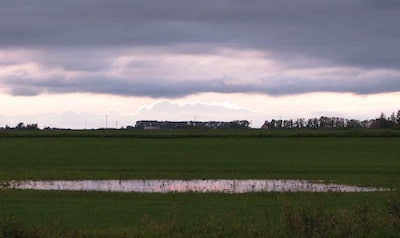Herbicides sprayed on cool, cloudy days that follow cool nights will have lower or slower efficacy than those applied on warm, sunny days. Herbicides tend to work best in warm, sunny conditions when weeds are actively growing and cycling nutrients into their growing points.
Cloudy days don’t provide the photosynthetic activity required for many herbicides, including Group 10 glufosinate. And nights near freezing followed by days with highs that barely reach 10°C will not provide high metabolic activity required for best results from Group 9 glyphosate.
Performance is on a sliding scale
- Low end performance: Cloudy days with highs of 10°C after a night near 0°C will tend to result in herbicide performance at the low end.
- Moderate performance: Sunny days with highs of 15°C after a night of 3°C will provide improved control.
- Optimum performance: Sunny days with highs of 20-25°C after a night of 10°C will provide optimum control.
Cool, humid conditions are also prime conditions for herbicide injury to the crop. The leaf cuticle (waxy layer) is thinner in these conditions. This allows for more rapid uptake of herbicide into the plant and cool conditions reduce the speed at which crop inactivates the herbicide. This can lead to a flash of injury in the crop. This injury is temporary in most cases. Once good growing conditions return, the crop recovers and yield loss is rare.
Ask product reps how they will support the use of their product when applied in cool temperatures. Set expectations according to weather conditions.
Questions and answers
Clark Brenzil, provincial specialist in weed control with the Saskatchewan Ministry of Agriculture, provides detailed answers to the following 3 questions:
What would 0°C mornings and 10°C highs with cloud and rain do for herbicide efficacy?
In this case, herbicide activity on that cloudy cool day would be next to zero. Biological activity would have stopped during the night, and would not start up again until the plant warmed to at least 5°C — and even then it would be very slow. A few hours between 5°C and a daytime peak of 10°C would not be enough warmth to get plant metabolism going to a point where herbicide was all that effective, especially with the cloud. No biological activity = no herbicide activity. Ideally, you want a day or two of warm sunny days and night time lows of 4°C or higher before spraying. If applied more than 48 hour before the event, efficacy on living plants will be improved and the plant will continue to decline when it warms up again.
Do any herbicides work well in these conditions?
Group 4 herbicides — such as clopyralid (in Lontrel) — tend to be less impacted by cool weather because they are somewhat plant persistent (are not quickly deactivated) in susceptible species and will remain active in the plant after the weather turns again. In addition they are less associated with a particular site of action in the plant because they are mimicking the plant’s natural growth regulators.
Soil residual herbicides in any group have a certain performance edge under adverse weather over their non-persistent counterparts. The soil residue re-exposes the plant to the herbicide when conditions improve and the weed control takes place then. Beware of the potential for injury in these cases since the cold has shut down the tolerant plant’s mechanism for ridding itself of the herbicide but the soil residue still allows the herbicide to build up in the plant as the uptake from the roots continues as long as the plant continues to respire.
Some non-Group-4 herbicides like Amitrol 240 are also plant persistent and as a result will pick up where it left off when it got cold — if the target was treated ahead of the cold weather. Keep in mind though that treating during cold weather can also slow the movement of the herbicide from the leaf surface into the plant and leave it vulnerable to wash off or other degradation.
What is better – lower efficacy of an early spray or waiting a week for better conditions?
Growers should not get in a panic to spray when cold and grey. Calendars are human inventions and plants don’t look at them. If it is cold, the “time” from a plant growth perspective has slowed to a snail’s pace or stopped. It will resume when temperatures warm up again. The point is under cool/cold temperatures and cloudy rainy conditions the plants will not continue to get bigger.

